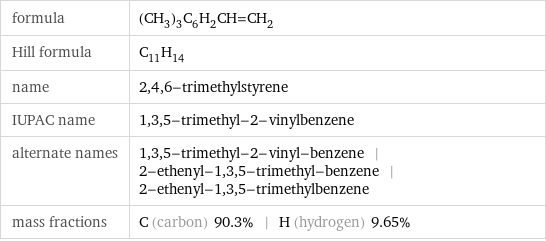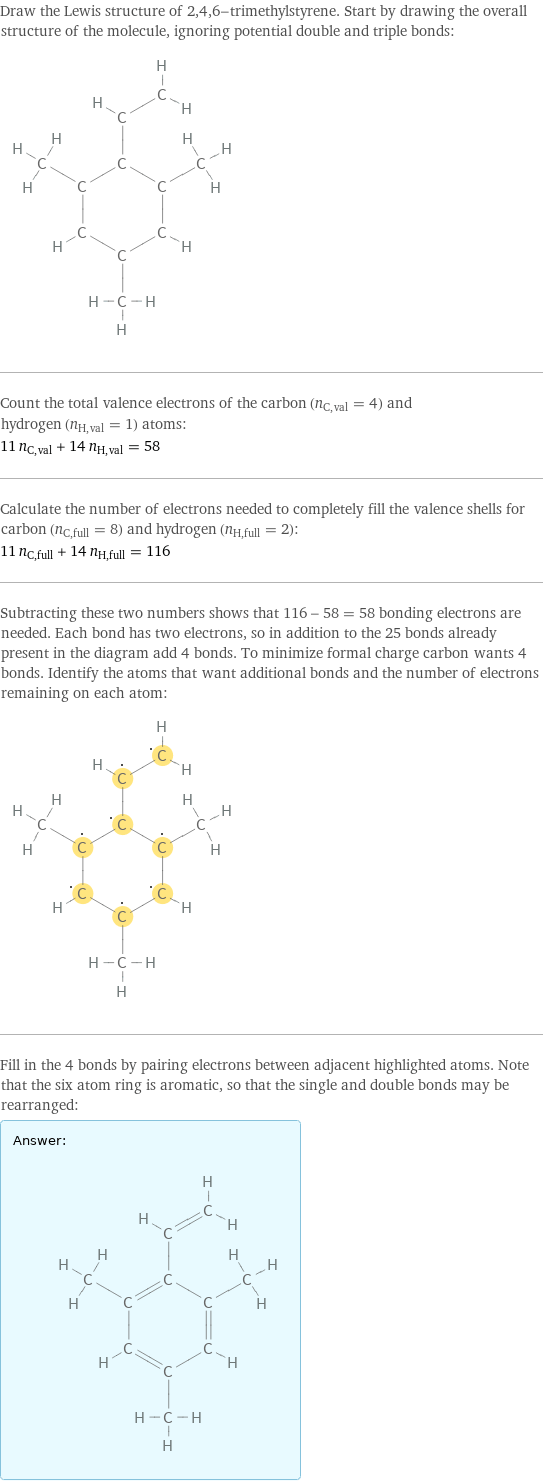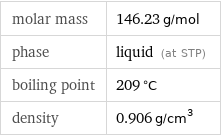Input interpretation

2, 4, 6-trimethylstyrene
Chemical names and formulas

formula | (CH_3)_3C_6H_2CH=CH_2 Hill formula | C_11H_14 name | 2, 4, 6-trimethylstyrene IUPAC name | 1, 3, 5-trimethyl-2-vinylbenzene alternate names | 1, 3, 5-trimethyl-2-vinyl-benzene | 2-ethenyl-1, 3, 5-trimethyl-benzene | 2-ethenyl-1, 3, 5-trimethylbenzene mass fractions | C (carbon) 90.3% | H (hydrogen) 9.65%
Lewis structure

Draw the Lewis structure of 2, 4, 6-trimethylstyrene. Start by drawing the overall structure of the molecule, ignoring potential double and triple bonds: Count the total valence electrons of the carbon (n_C, val = 4) and hydrogen (n_H, val = 1) atoms: 11 n_C, val + 14 n_H, val = 58 Calculate the number of electrons needed to completely fill the valence shells for carbon (n_C, full = 8) and hydrogen (n_H, full = 2): 11 n_C, full + 14 n_H, full = 116 Subtracting these two numbers shows that 116 - 58 = 58 bonding electrons are needed. Each bond has two electrons, so in addition to the 25 bonds already present in the diagram add 4 bonds. To minimize formal charge carbon wants 4 bonds. Identify the atoms that want additional bonds and the number of electrons remaining on each atom: Fill in the 4 bonds by pairing electrons between adjacent highlighted atoms. Note that the six atom ring is aromatic, so that the single and double bonds may be rearranged: Answer: | |
3D structure

3D structure
Basic properties

molar mass | 146.23 g/mol phase | liquid (at STP) boiling point | 209 °C density | 0.906 g/cm^3
Units

Liquid properties (at STP)

density | 0.906 g/cm^3 refractive index | 1.532
Units

Chemical identifiers

CAS number | 769-25-5 PubChem CID number | 13036 PubChem SID number | 24855435 SMILES identifier | CC1=CC(=C(C(=C1)C)C=C)C InChI identifier | InChI=1/C11H14/c1-5-11-9(3)6-8(2)7-10(11)4/h5-7H, 1H2, 2-4H3 MDL number | MFCD00008613
Safety properties

flash point | 75 °C